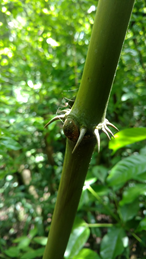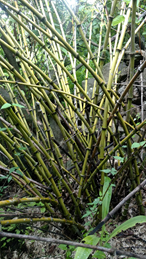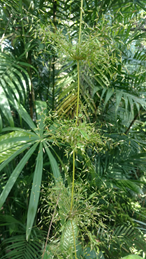Introduction
In Jalisco, Mexico, the dry tropical forests that border the Pacific Ocean are home to a unique diversity of plants and animals. Dry tropical forests are characterized by a pronounced dry period, which lasts for several months and spurs a variety of adaptations among its plants and animals. Jalisco’s dry tropical forests host almost 1,200 plant species, 16 percent of which are endemic.
This rare ecosystem is under threat. In the last 50 years, Mexico has seen widespread deforestation, losing 775,800 hectares of forests annually, and Jalisco has not been spared. The forests of Jalisco are encroached upon by logging, agriculture, and commercial and residential development. There are only two major federally protected natural areas in Jalisco (The Biosphere Reserve of Chamela-Cuixmala and the Biosphere Reserve of the Sierra de Manantlán), and they cover only 10 percent of the original ecoregion. As such, the Vallarta Botanical Garden plays an essential role as a refuge for threatened species.
An area of the Serranías Meridionales of Jalisco, which is within close proximity of the Vallarta Botanic Garden, was found as one of two locations in the country with the highest levels of oak endemism and species richness. 20 percent of Mexico’s 67 species of bromeliads are found in Jalisco. Mexico is the western hemisphere’s leader in magnolia diversity with 50 threatened species described. In Jalisco alone, there are 5 threatened magnolia species: Magnolia iltisiana (Vulnerable (VU)), Magnolia ofeliae (Critically Endangered(CR)), Magnolia jaliscana (Endangered(EN)), Magnolia pugana (EN) and Magnolia vallartensis (CR). The Vallarta Botanical Garden practices in-situ and ex-situ conservation to safeguard these species.
Vallarta Botanical Garden’s conservation focus and expertise is in oaks, orchids, bromeliads, magnolias and cycads. Established in 2004, founder and horticultural enthusiast, Robert Price, formed the gardens to consist of a planted garden with native and exotic species, as well as a forest preserve. In 2016, Vallarta Botanical Garden became the first Latin American garden to receive ArbNet accreditation. The Vallarta Botanical Garden plans to continue expanding its preserve to safeguard the surrounding landscape from further development.
The forest preserve
In 2017, Vallarta Botanical Garden received a donation of land from garden benefactor, Ralph Osborne, who sits on the Board of Directors, for the purpose of conservation, providing the garden with the opportunity to expand its impact in these filed. The new land parcel increases the forest preserve's footprint from six hectares to nearly twenty-eight.
The new parcel is comprised of semi-deciduous tropical forest and riparian tropical forest. The forst is intersected by the Los Horcones River, the banks of which support a rich plant diversity. This riparian zone, which stands as an interface between the river and land, is critically importnat for many native animals. Both sections of the forest are diverse in forest type, with a good conservation status (forest of intermediate age and old growth). There are several patches of secondary vegetation such as, distrubed forest, forest clearings, pioneer vegetation of young successional stages, composed of herbs, shrubs, lianas, bamboos, and young trees.
Map of the expanded forest preserve with vegetation types observed during the botanical study. Top left corner is a zoomed in images of Los Horcones River that borders the forest preserve and the gardens at Vallarta Botanical Garden. Map and image from Vallarta Botanical Garden.
Key species and conservation potential
To bolster the Vallarta Botanical Garden’s conservation program, the garden was awarded U.S. $1,000 as a recipient of the ArbNet/Botanical Gardens Conservation International (BGCI) Capacity Building Grant in 2017. The grant funded a botanical study of the Vallarta Botanical Garden’s forest preserve. The immediate objective of this project was to gain a clear understanding and documentation of flora biodiversity that exists within the new land acquisition. This study was the first step in establishing a robust conservation program, including species assessment research, forest species preservation and conservation management research.
In April 2018, members of Puerto Vallarta Botanical Garden’s Science Advisory Board, including Vallarta Botanical Garden staff and researchers from the University of Guadalajara, to complete the botanical study. The results of which were analyzed by researchers at the University of Guadalajara.
Forest preserve biodiversity study team in April 2018 at Vallarta Botanical Garden. Image from Vallarta Botanical Garden monthly publication, the Leaflet (April 2018).
|
Tabel 1. Total species composition documented in the botanical study within the Vallarta Botanical Garden’s forest preserve. |
|
Category |
Number of Species |
|
Total Species |
193 |
|
Total Families |
64 |
|
Tabel 2. Conservation status of species observed in the forest preserve. |
|
IUCN Status |
Number of Species |
Species Name |
|
Not Evaluated (NE)* Species |
174 |
Various |
|
Least Concerned (LC) Species |
16 |
Chamaedorea pochutlensis, Acanthocereus tetragonus, Commelina diffusa, Hymenaea courbaril, Guarea glabra, Ficus velutina, Encyclia spatella, Epidendrum difforme, Epidendrum ciliare, Pinus maciminoi, Echinochloa colona, Acrostichum danaeifolium, Adiantum capillus-veneris, Aspleium formosum, Salix humboldtiana, Cecropia obtusifolia |
|
Vulnerable (VU) Species |
1 |
Oreopanax peltatus |
|
Endangered (EN) Species |
2 |
Vanilla pompona and Vanilla inodora |
|
*A Not Evaluated (NE) species means that a species has not been assessed by the International Union for Conservation of Nature (IUCN) Red List of threatened species. This does not however mean that the species is not threatened or even at risk of extinction. |
Because there are so many unevaluated species, the preserve holds tremendous potential for species assessment of threatened and endangered species, as well as conservation research and action. Although the forest preserve at the time does not contain an abundance of oak species or any species of magnolia, Director Neil Gerlowski says that there are plans to continue the expansion of the forest preserve. Such an expansion might include these species for in situ conservation.
|
Tabel 3. Species of conservation focus or concern observed in the forest preserve of the Vallarta Botanical Garden documented in the botanical study. |
|
Family (Conservation Focus) |
Number of Species |
Species Name |
|
Orchid |
16 |
Barkeria palmeri (NE), Clowesia dodsoniana (NE), Encyclia spatella (Least Concerned (LC)), Epidendrumm difforme (LC), Epidendrum ciliare (LC), Guarianthe aurantiaca (NE), Dendrophylax porrectus (NE), Meiracyllium trinasutum (NE), Laelia rubescens (NE), Notylia barkeri (NE), Oncidium leleui (NE), Prosthechea trulla (NE), Trichocentrum ascendens (NE), Sarcoglottis sceptrodes (NE), Vanilla popona (EN), Vanilla inodora (EN) |
|
Bromeliad |
9 |
Achemea bracteata (NE), Acemea mexicana (NE), Bromelia pinguin (NE), Tillandsia schiedeana (NE), Tillandsia compressa (NE), Tillandsia pacifica (NE), Tillandsia jaliscomonticola (NE), Tillandsia setacea (NE), Tillandsia usneoides (NE) |
|
Cycad |
1 |
Dioon tomaselii (VU) |
Several species stood out to Vallarta Botanical Garden’s Staff Biologist Leonardo Campos for their beauty or rarity: Calophyllum brasiliense (LC), Vanilla pompona (EN), Dioon edule (LC), Dioon tomeseliI (VU), Bletia purpurea (NE), Chusquea liebmanii (NE), Selenicereus sp (NE).



Costa Rican Weeping Bamboo (Chusquea liebmanii). Image taken in the Vallarta Botanical Garden’s forest preserve. Image from Eduardo Ruiz Sánchez, Universidad de Guadalajara.
Dioon tomeseliI. Image taken in the Vallarta Botanical Garden’s forest preserve. Image from Brian Dorsey, The Huntington, Library, Art Collection, and Botanical Gardens.
Conclusion
With the addition of the forest preserve, Vallarta Botanical Garden’s conservation potential grew substantially. Because Jalisco is a biodiversity hotspot for many types of plants and animal species - some of which are threatened with extinction - the Vallarta Botanical Garden’s forest preserve serves as a catalysis for the conservation of endemic woody species, orchids and bromeliads in Jalisco. Continually, the forest preserve is a model example for in situ conservation for Mexico and across Latin America.
Vallarta Botanical Garden casts a large net by establishing partnerships with organizations including the American Public Gardens Association (APGA), ArbNet, BGCI, Franklinia Foundation, La Asociación Mexicana de Jardines Botánicos (AMJB), Magnolia Society International, The Morton Arboretum and Mt. Cuba Center, as well as research institutes and universities. The Vallarta Botanical Garden radiates this model across Mexico and Latin America through collaboration, consultation and attendance of the AMJB annual conference during which they share their successes and encourage other gardens to cultivate these sorts of relationships.
Resources
Aragón, C. Flores, M. Holland, N. Homel, G. Edited by Gerlowski, N. Price, B. (April 2018). The Leaflet April 2018: The Monthly Magazine of the Vallarta Botanical Gardens. Vallarta Botanical Garden 8, no. 4.
Carvajal, I.B. Cazares, E. Flores, M. Gomez, M. Haynes, A.M. Homel, Edited by Gerlowski, N. Price, B. (June 2017). The Leaflet April 2018: The Monthly Magazine of the Vallarta Botanical Gardens. Vallarta Botanical Garden 7, no.6.
Espejo-Serna, A. López-Ferrari, A. (1999). Mexican Bromeliaceae: diversity and notes on their conservation. Harvard Papers in Botany: 119-128.
Flores, M. Hernández, H. Homel, G. Kopfstein, R. Rouyer, A. Edited by Gerlowski, N. Price, B. (April 2016). The Leaflet April 2016: The Monthly Magazine of the Vallarta Botanical Garden. Vallarta Botanical Garden 6, no. 4.
Gerlowski, N. Muñiz-Castro, M. (2017). The Vallarta Botanical Garden’s advancement in conserving the diversity of native Mexican oaks and magnolias In Sniezko, R. Man, G. Hipkins, V. Woeste, K. Gwaze, D. Kliejunas, J. McTeague, B. (2017) Gene conservation of tree species--banking on the future. Proceedings of a workshop. Gen. Tech. Rep. PNW-GTR-963. Portland, OR: U.S. Department of Agriculture, Forest Service, Pacific Northwest, Research Station. p. 126.
Lott, E.J. Bullock, S. Solís, J.A. (1987). Floristic diversity and structure of plan and arroyo forests of coastal Jalisco. Biotropica 19: 228-235.
Reich, R. Bonham, C. Aguirre-Bravo, C. Chazaro-Basañeza, M. (2010). Patterns of tree species richness in Jalisco, Mexico: relation to topography, climate and forest structure. Plant Ecology 210, no. 1: 67-84.
Rivers, M. Beech, R. Murphy, L. Oldfield, S. (March 2016). The Red List of Magnoliaceae: Revised and extended. International Conservation for Union of Nature. Retrieved from: http://globaltrees.org/wp-content/uploads/2016/03/Magnoliaceae_RedList20...
Torres-Miranda, A. Luna-Vega, I. Oyama, K. (2011). Conservation biogeography of red oaks (Quercus, section Lobatae) in Mexico and Central America. American Journal of Botany 98, no. 2): 290-305.
Velásquez, A., Mas, J.F., Díaz- Gallegos, J.R. Mayorga-Saucedo, P.C. Alcantara, R. Castro, T.F. Bocco, G. Ezcurra, E. Palacio, J.L. (2002). Patterns and land use change in Mexico. Gaceta 62: 21-37. Instituto Nacional de Ecología. SEMARNAT, México.
Jalisco dry forests. World Wildlife Fund. Retrieved from: http://www.worldwildlife.org/ecoregions/nt0217
~ Sasha Kramer

